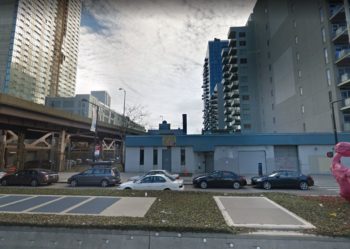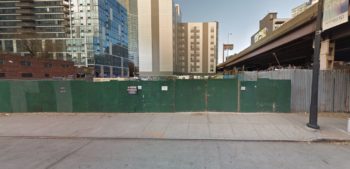
Proposed development site of 26-32 Jackson Avenue next to the Queensboro Bridge approach ramps. Image Credit: Google Maps
Community members voiced concerns about infrastructure and affordability for the proposed addition of almost 500 units. On September 17, 2018, the City Council Subcommittee on Zoning and Franchises heard an application by the Department of Housing Preservation and Development (HPD) and the Department of Citywide Administrative Services (DCAS) for a proposed two-building mixed-use, mixed-income project on Jackson Avenue in Long Island City, Queens. The developers, Lions Group NYC, and Fetner Properties, also applied for special permits to modify building setback requirements and to create a parking garage.
The first building will be located at 27-01 Jackson Avenue. The second building will be located at 26-32 Jackson Avenue. The project sites are adjacent to the Queensboro Bridge approach ramps. The Queensboro Bridge approach ramps connect the bridge to Thomson Avenue bringing traffic from Manhattan into Long Island City. As a result, many local groups refer to this project as the “Long Island City ramps” project.
The 27-01 Jackson Avenue building will be 27 stories and 323 feet high. The building will contain retail space on the first floor, a public parking garage with 91 parking spots on the second and third floors, mechanical space on the fourth floor, approximately 120 residential units on the sixth through 25th floor, and would have amenities for residents on the fifth and 26th floor. Currently, the 27-01 Jackson Avenue site is an empty lot.
The 26-32 Jackson Avenue site will be a 49-story and 514-foot-high building with retail use on the first two floors, mechanical space on the third floor and residential use on the remaining floors. There is currently a one-story building at 26-32 Jackson Avenue.
The buildings will have 481 residential units in total. According to HPD, of those 481 units, approximately 150 units will be designated as affordable housing in a range of eligible AMI. Twenty-two units will be set at 60% AMI, 18 units will be set at 90% AMI, 14 will be set at 110% AMI, and 96 units will be set at 130% AMI.
The applications triggered the ULURP process because the project involves the disposition of City-owned property. HPD and DCAS sought approval for the disposition of light and air rights from the City-owned parcel under the Queensboro Bridge ramps adjacent to the proposed project sites. The City acquired the property to build the Queensboro Bridge approach ramps in the 1950’s. As the ramps are not recorded as mapped streets, the City-owned lots have retained full development rights. The developers needed to purchase the air rights over the City-owned lots next door to build the buildings as designed.
On May 1, 2018, HPD, DCAS, and the developers filed the applications for 26-32 Jackson Avenue. On May 3, 2018, HPD, DCAS, and the developers filed the applications for 27-01 Jackson Avenue. On May 7, 2018, the City Planning Commission reviewed and certified the applications for both sites.
On June 7, 2018, Queens Community Board 2 voted to disapprove the application with 33 votes in favor of disapproval, one vote in opposition, and no abstention. The Community Board was concerned that the proposal would “nearly tripl[e] the density” currently allowed as of right.
On June 11, 2018, in a letter to the City Planning Commission, the Community Board stated, “as presented in this application, the level of public benefit when compared to the FAR windfall that would be realized by the developer is woefully insufficient.” The Community Board highlighted possible forms of public benefit like a community center, open spaces, and spaces for arts.
On July 23, 2018, Queens Borough President Melinda Katz issued a recommendation of disapproval of the application unless the application met certain conditions like including community spaces and deeper affordable housing.
On July 25, 2018, the City Planning Commission held a public hearing on the applications. Eight people spoke in support of the application. No one spoke in opposition.
On August 22, 2018, the City Planning Commission issued reports approving the applications. According to the City Planning Commission reports, the Commission found that both proposed developments are “appropriate use of City-owned property associated with the Queensboro Bridge approach ramps, and it is consistent with, and contributes to, the surrounding neighborhood context.” The City Planning Commission found that there would be no significant impact on the environment.

Proposed development site for 27-01 Jackson Avenue. Image Credit: Google Maps
During the City Council Subcommittee on Zoning and Franchises’ hearing, Genevieve Michael of HPD stated that the Department of City Planning approved the sale of 362,683 square feet of air space, splitting 66,368 square feet for 27-01 Jackson Avenue and 296,315 square feet for 26-32 Jackson Avenue. For compensation from the developers for the air rights, the City would get a provision for permanently affordable housing units and a cash payment based on the average square foot rates for local residential sales. The affordable units will mirror the Mandatory Inclusion Housing program workforce option.
Genevieve Michael further stated that the combined benefit of the cash payment and the permanent affordable housing was worth more than the price of the air rights, so the City would benefit from this project with more money to invest in future affordable housing. She further stated that this was “an opportunity to provide much-needed housing for moderate and middle-income households” and to bring affordable housing to the area “without having to provide any subsidies beyond the development rights themselves.” In response to a question about the selected affordability, Genevieve Michael stated that the Department considered several options to maximize affordability, but pursuing a lower AMI requirement for all the affordable units would result in fewer affordable units overall or necessitate subsidies. If HPD were to set all the affordable units at only 60% AMI, only 72 affordable units would be created.
At the hearing, Brett Swanson of the Queens Chamber of Commerce spoke in support of the project, stating that the project would bring hundreds of jobs and generate economic activity for the businesses in the area. He stated it was the “right economic mix” for what is an otherwise unusable area near the off ramps.
Several people spoke in opposition to the project.
At the hearing, Council Member Jimmy Van Bramer voiced concerns about how the rapid overdevelopment has put a strain on Long Island City’s infrastructure and resources. He stated, “This project, of course, does not exist in a vacuum, it is but one part of the overall plan for Long Island City, and there are rightfully significant concerns in this community about the overall approach of this administration when it comes to Long Island City. I support and believe that those concerns are valid. This project is one where people, particularly in Court Square are concerned, especially when it comes to adding another 500 units of housing and what that would mean for an area that is already underserved when it comes to infrastructure.” Council Member Van Bramer also spoke about the need for green spaces and urged a need for a plan from the administration to add additional school seats in the neighborhood.
Sheila Lewandowski, the 2nd Vice Chair of Queens Community Board 2, spoke on behalf of the Board in opposition to the project.
Pedro Gomez of the Court Square Civic Association spoke in opposition stating that the community is highly concerned about the “hyper-development” in the neighborhood without the requisite investments in infrastructure and the community and that using public air rights to further contribute to the strain on the community by threefold was “unconscionable.”
Brent O’Leary of the Hunter’s Point Civic Association spoke in opposition stating that the neighborhood “was in sincere crisis” and that the community lacked the resources like school seats, a senior center, community center and an adequate sewer system to handle the growing community.
Mary Bradley of the Long Island City Coalition elaborated on the sewer system problem, stating that the sewer lines already back up when there is rain and that untreated sewage is commonly seen in nearby Gantry Park. She noted that this sewage soaks into the ground and causes a health hazard for the families that frequent the park, and fears that the additional units in this project would make an “already failing system” worse.
Additional speakers opposed the project because they believed the 130% AMI was not genuinely affordable housing.
The Subcommittee will vote on the application at a later date.
By: Veronica Rose (Veronica is the CityLaw Fellow and a New York Law School Graduate, Class of 2018.)


FWIW I spoke at this hearing, certainly about the affordable housing but also need for open spaces at DOT Lots.
http://www.courtsquarecivic.org/dot-lots/